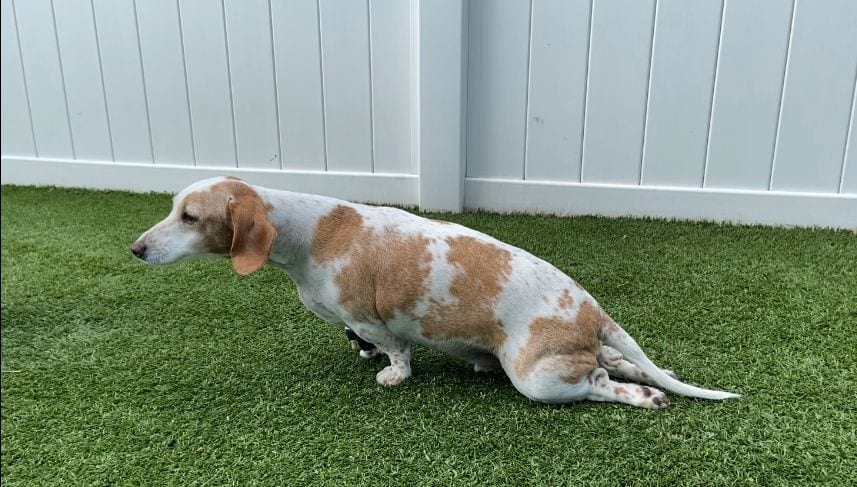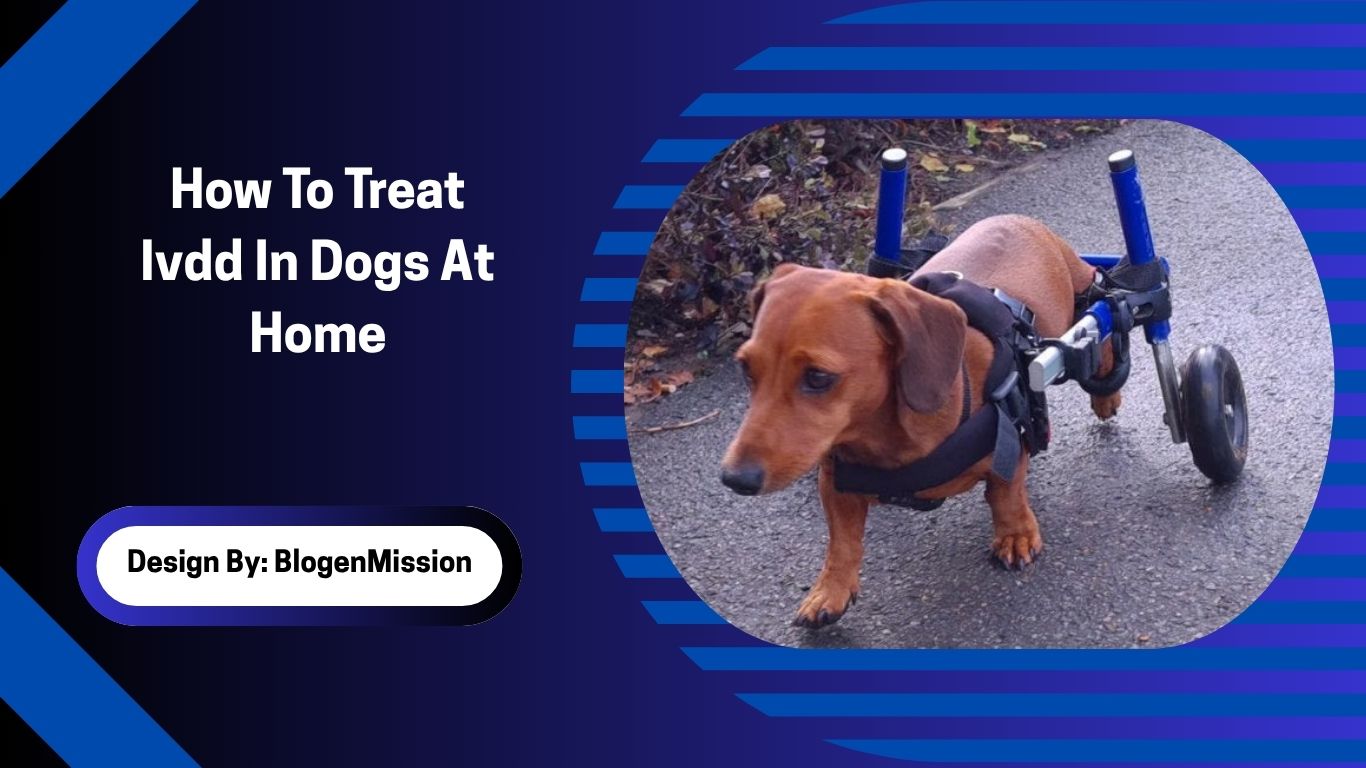Treating IVDD in dogs at home involves crate rest, pain management, physical therapy, natural remedies, supplements, and daily care routines to support healing, reduce inflammation, and improve your dog’s mobility.
Intervertebral Disc Disease (IVDD) is one of the most common spinal conditions affecting dogs, particularly in breeds like Dachshunds, French Bulldogs, and Cocker Spaniels. While severe cases may require surgery, many mild to moderate cases can be managed at home with a conservative, non-surgical approach.
If you’re wondering how to treat IVDD in dogs at home, this guide covers everything from natural treatments to daily care routines, helping your dog heal in a safe and supportive environment.
Understanding IVDD in Dogs
IVDD occurs when the cushioning discs between a dog’s vertebrae bulge or rupture, causing pain, inflammation, and potentially even paralysis. It’s sometimes referred to as a slipped disc in dogs or spinal disc disease in dogs.
Common Symptoms:
- Sudden reluctance to move or jump
- Crying out when touched or picked up
- Wobbly or weak rear legs
- Muscle spasms or tense abdomen
- Loss of bladder or bowel control (severe cases)
If your dog shows any of these IVDD symptoms, consult your veterinarian immediately. After a diagnosis, many dogs respond well to IVDD home treatment if the condition is caught early.
Conservative IVDD Management in Dogs

For dogs not requiring surgery, a conservative management plan focuses on rest, pain relief, and rehabilitation. This non-invasive approach can effectively restore mobility and reduce discomfort over time.
Crate Rest for IVDD Recovery
Strict crate rest is the cornerstone of at-home IVDD treatment. It allows the spinal discs to heal by limiting movement.
How to implement crate rest:
- Use a crate or small pen for 4 to 8 weeks
- Only allow movement for potty breaks (with support)
- Avoid stairs, furniture, and jumping at all costs
- Use calming supplements or vet-approved medications to reduce anxiety
This phase is essential in the dog back injury healing timeline and helps avoid worsening the condition.
Dog IVDD Pain Relief at Home
Pain control is critical. Your vet may prescribe anti-inflammatory medications and painkillers, but you can also explore natural treatments for dog IVDD.
Natural Pain Relief Options:
- Warm compresses (applied gently to the spine)
- CBD oil or hemp-based supplements (vet-approved)
- Acupuncture or cold laser therapy (if available nearby)
- Herbal anti-inflammatories like turmeric or boswellia (under guidance)
These options help reduce inflammation in the dog’s spine and promote comfort during recovery.
Home Exercises for Dogs with Back Injury
After the crate rest period, controlled and guided home exercises are key to rehabilitation.
Gentle Rehab Techniques:
- Assisted standing and slow walking on a non-slip surface
- Passive range-of-motion exercises (moving legs gently while the dog lies down)
- Light massage to encourage circulation
- Supervised swimming or hydrotherapy (if recommended)
These at-home dog rehabilitation techniques promote healing and improve strength, balance, and flexibility.
Supplements for IVDD Recovery
Nutrition plays a vital role in spinal healing. Here are some supplements for IVDD recovery that can support your dog’s healing process:
- Omega-3 fatty acids – to reduce inflammation
- Glucosamine & chondroitin – to support spinal disc and joint health
- Vitamin B-complex – for nerve regeneration
- Antioxidants – to fight cellular damage and improve immunity
These can be part of a vet-approved plan to support mobility in dogs with IVDD.
Daily Care for Dogs with IVDD
Your dog’s day-to-day routine will require adjustment during recovery.
Tips for Daily IVDD Home Care:
- Use harnesses instead of collars
- Place food/water bowls at head level to avoid strain
- Keep their area warm, clean, and stress-free
- Use ramps to avoid jumping or climbing
- Monitor for signs of relapse or pain
- Maintain regular check-ins with your vet
Daily care for dogs with IVDD ensures they remain comfortable while minimizing the risk of reinjury.
IVDD Flare-Up Home Remedies
Even after recovery, some dogs may experience flare-ups. Catching and managing these early can prevent serious setbacks.
IVDD Flare-Up Tips:
- Reinstitute crate rest for 3–5 days
- Administer prescribed or natural pain relief
- Apply heat therapy (warm compress)
- Reduce physical activity
- Monitor symptoms and contact your vet if worsened
Having a flare-up plan in place can speed up recovery and maintain your dog’s quality of life.
How to Prevent IVDD Recurrence in Dogs?

Once a dog has had IVDD, they’re more likely to experience it again. Prevention is key to long-term spinal health.
Prevention Tips:
- Keep your dog at a healthy weight
- Avoid jumping off furniture—use ramps
- Strengthen core muscles through regular rehab exercises
- Feed a balanced, joint-supportive diet
- Avoid rough play or high-impact activities
These strategies can help prevent IVDD recurrence in dogs, especially in breeds predisposed to spinal issues.
In-Home Care for Paralyzed Dogs
If your dog experiences partial or full paralysis, in-home care for paralyzed dogs involves deeper commitment but is very possible with the right setup.
Essentials:
- Dog diapers or belly bands
- Drag bags or wheelchairs for mobility
- Regular bladder expression (taught by a vet)
- Padding to prevent bedsores
- Ongoing physical therapy
Many dogs live happy, fulfilling lives after paralysis with compassionate and consistent care.
FAQs:
1. Can a dog recover from IVDD without surgery?
Yes, many dogs with mild to moderate IVDD recover through conservative treatment including crate rest, pain relief, and physical therapy. Close monitoring and a vet-approved plan are essential for safe, effective home recovery.
2. What are the best home exercises for IVDD recovery?
Gentle exercises like assisted walking, passive leg movements, and short leash walks on non-slip surfaces help build strength. Always consult your vet before starting any exercise after crate rest ends.
3. How can I relieve my dog’s IVDD pain naturally?
Use warm compresses, calming supplements, and vet-approved herbal remedies like turmeric or CBD oil. These natural treatments can reduce spinal inflammation and complement prescribed medications for better pain management.
4. How long does IVDD recovery take at home?
Recovery typically takes 4 to 8 weeks with proper crate rest, followed by rehabilitation. Severe cases or relapses may take longer. Regular vet checkups are important to track progress and avoid setbacks.
5. What should I avoid during IVDD home care?
Avoid letting your dog jump, climb stairs, or walk on slippery floors. Don’t skip crate rest or overdo exercises. Avoid harsh handling and unverified treatments that could worsen spinal stress or pain.
Conclusion:
Caring for a dog with IVDD at home is challenging but rewarding. Through strict crate rest, gentle exercises, pain management, and supportive care, many dogs can regain comfort and mobility without surgery. Natural remedies, anti-inflammatory supplements, and environmental modifications play a crucial role in healing. With patience, consistency, and guidance from your vet, home treatment of IVDD is not only possible—it’s often successful. A thoughtful routine and proactive care can give your dog a strong chance at recovery and a happy, active life.
Related Post:
- Can Dogs Eat Chicken Hearts – Pros, Cons & Safe Serving Tips!
- Why Does My Dog Have Diarrhea At Night
- How Often Rabies Shot Dog – Guide for Pet Owners!
